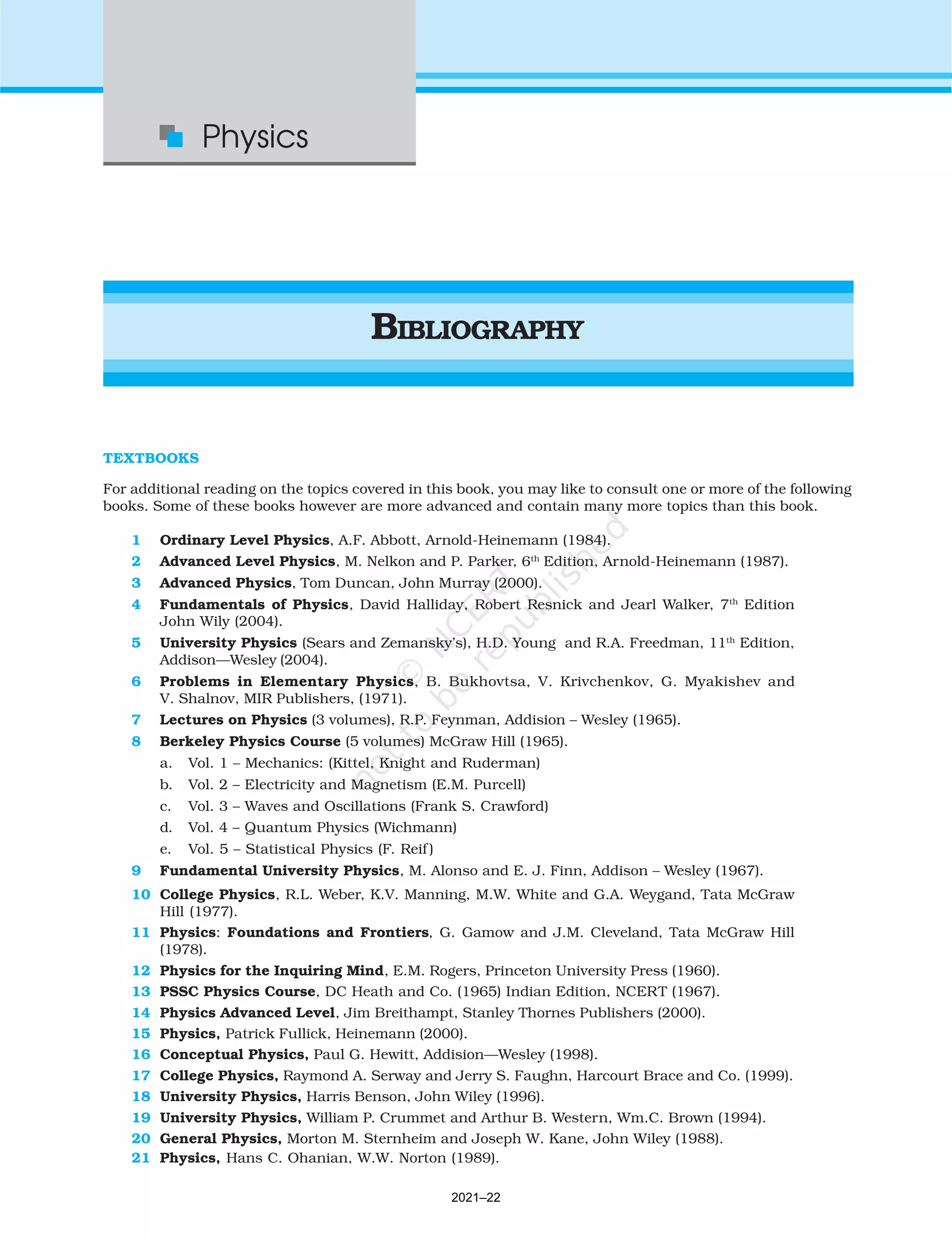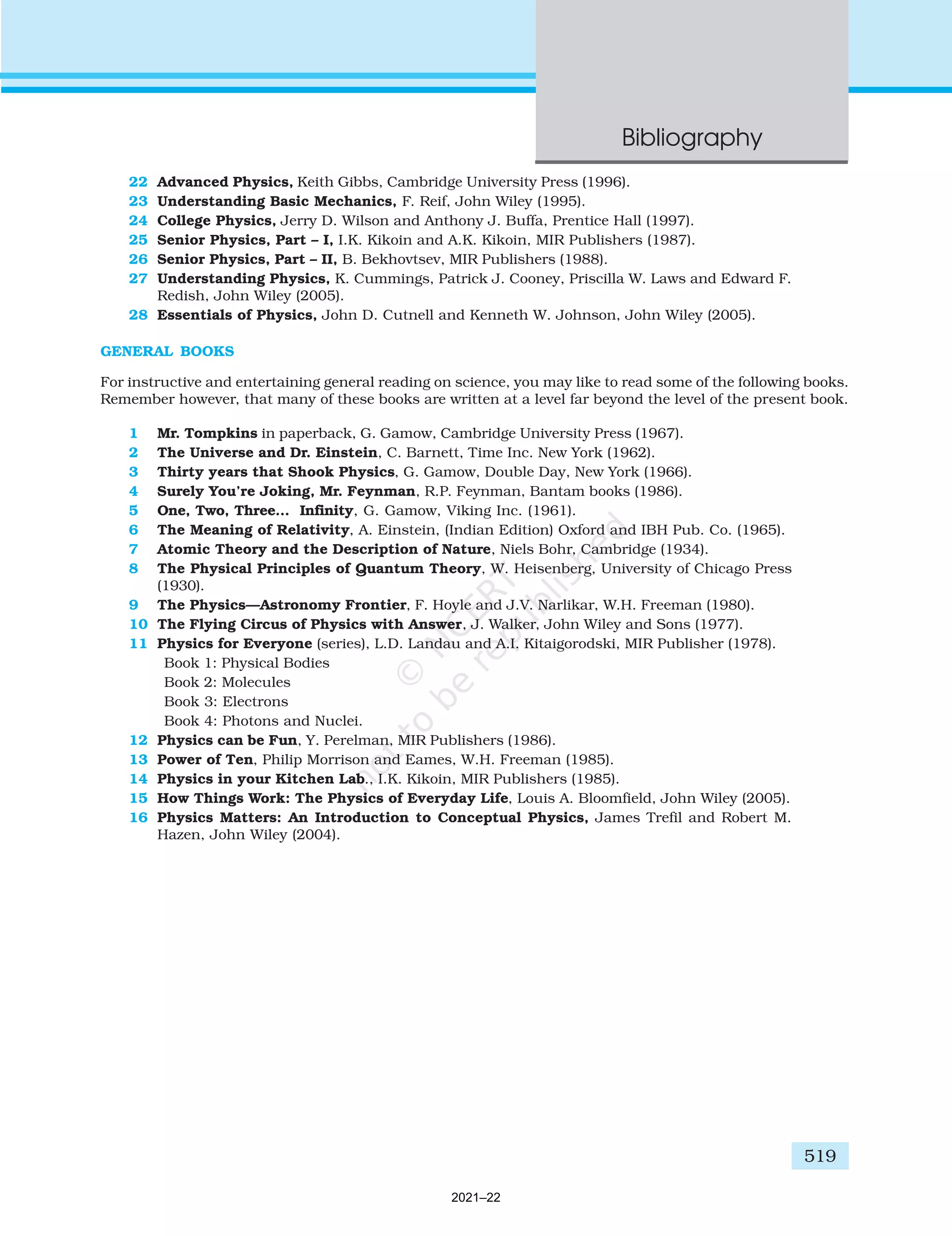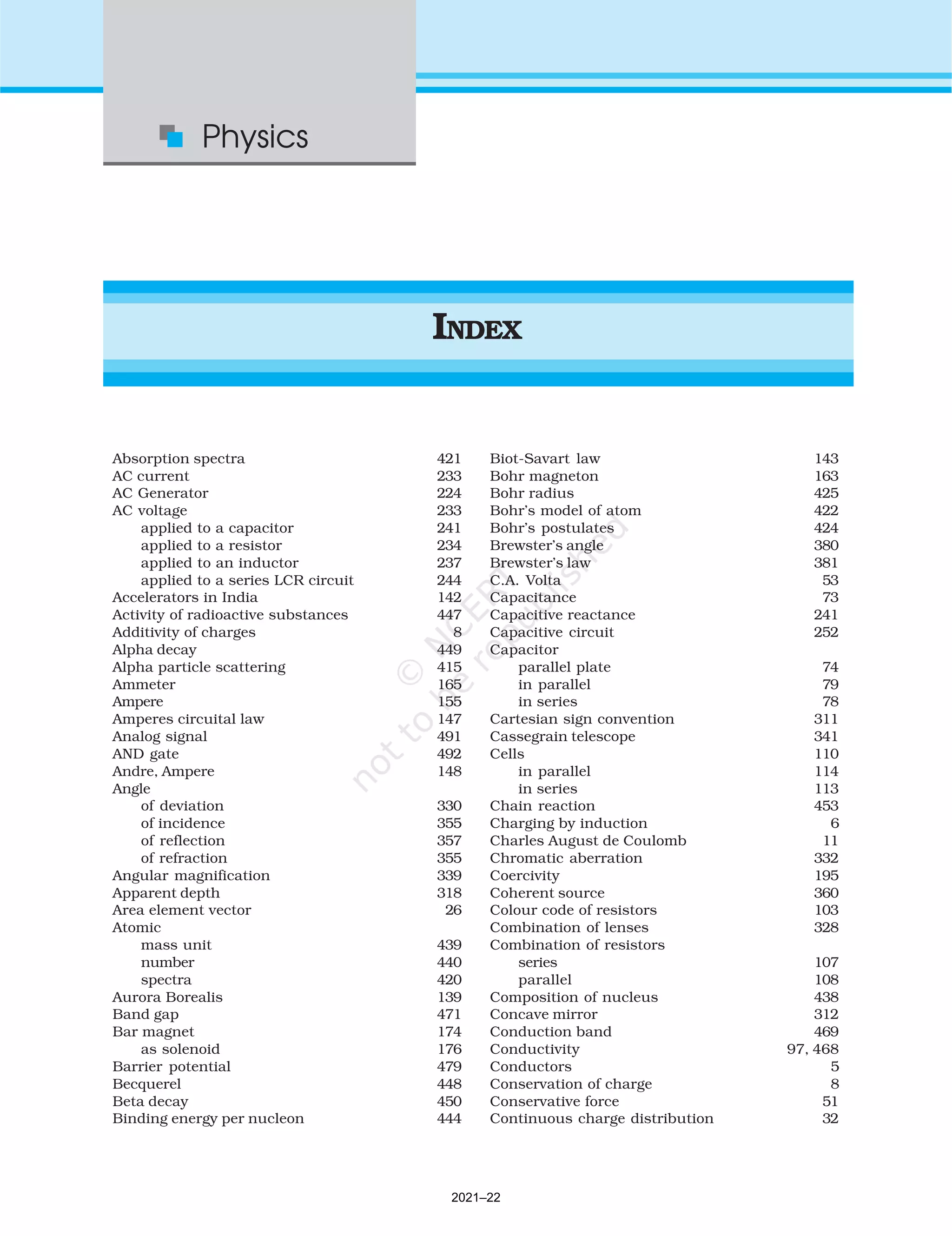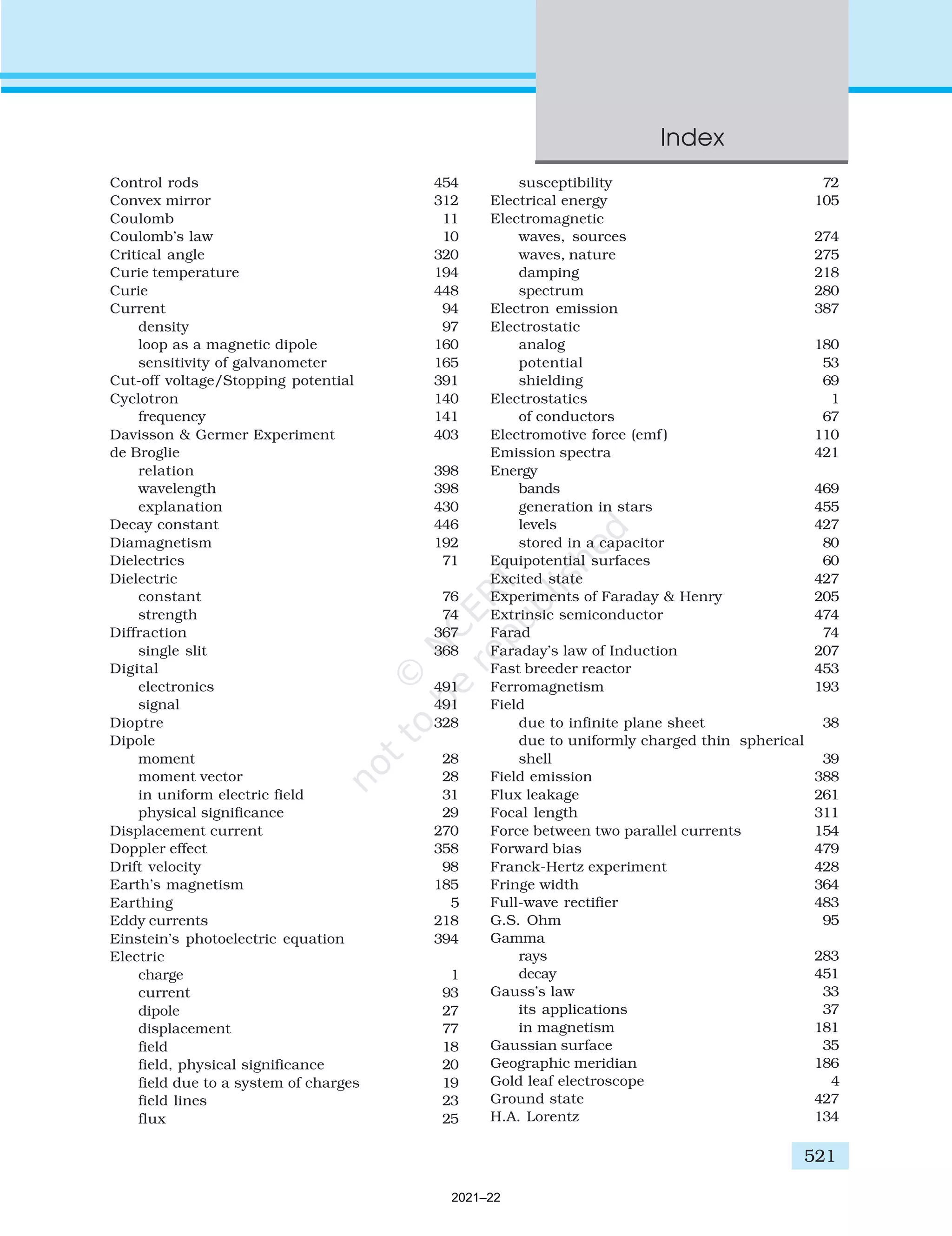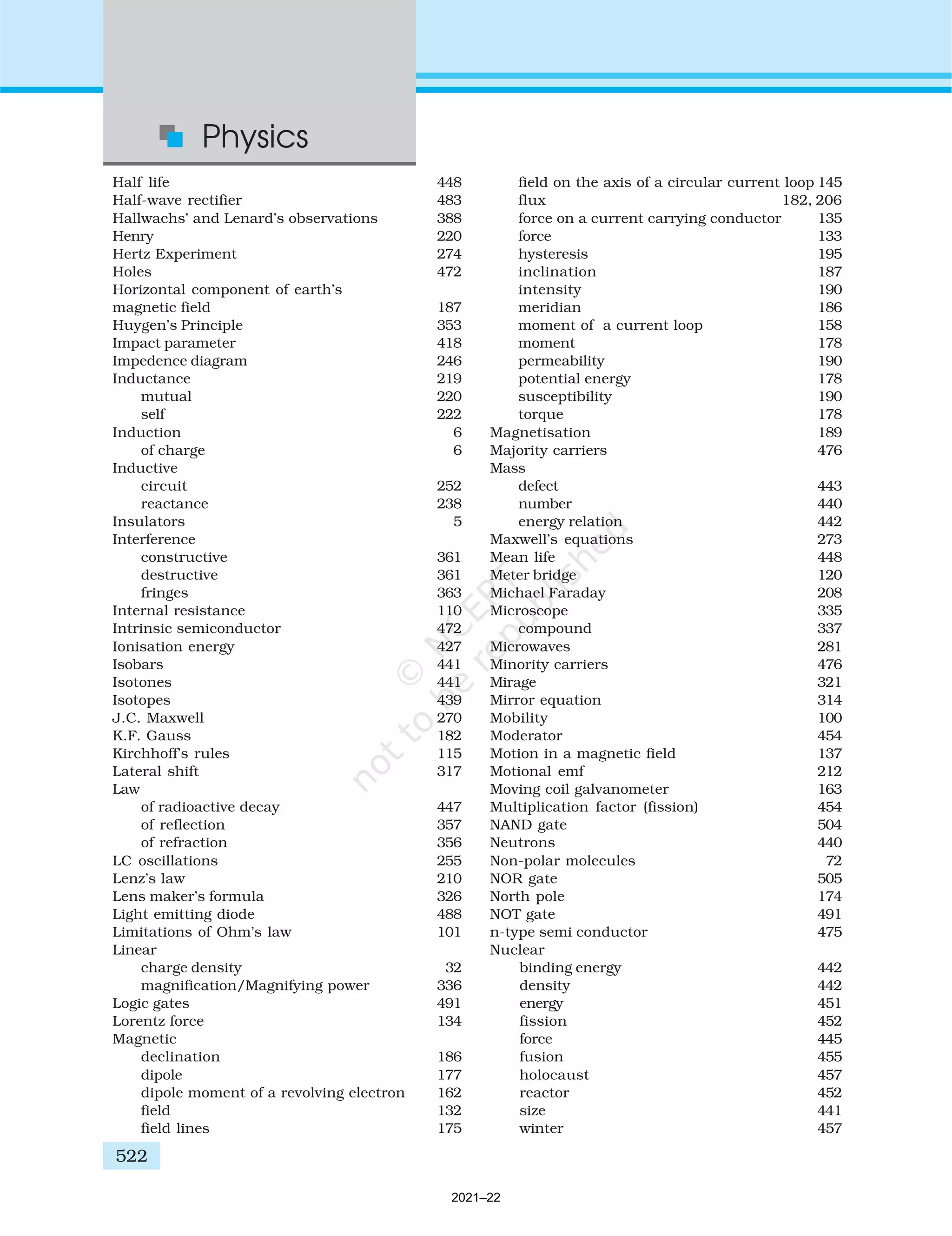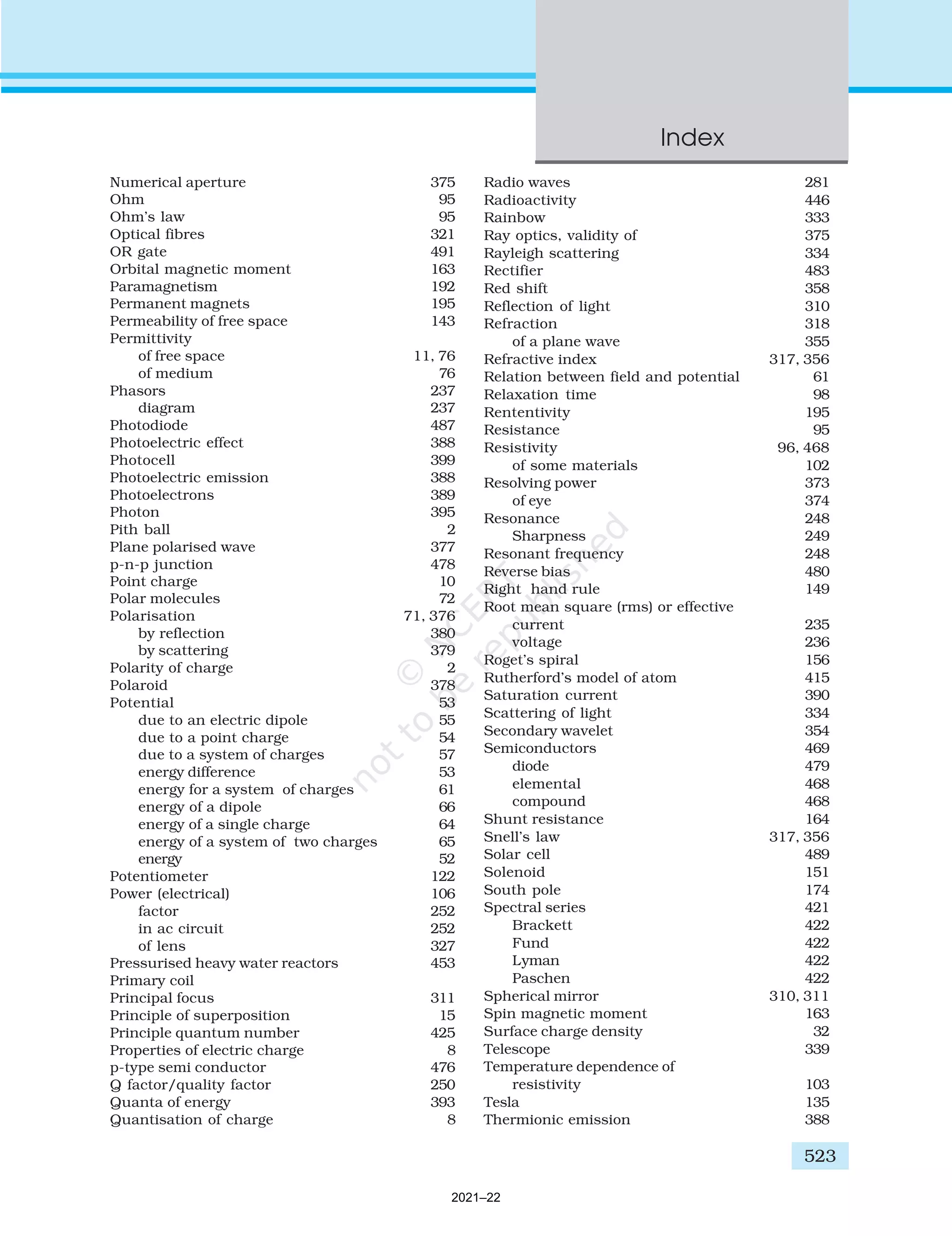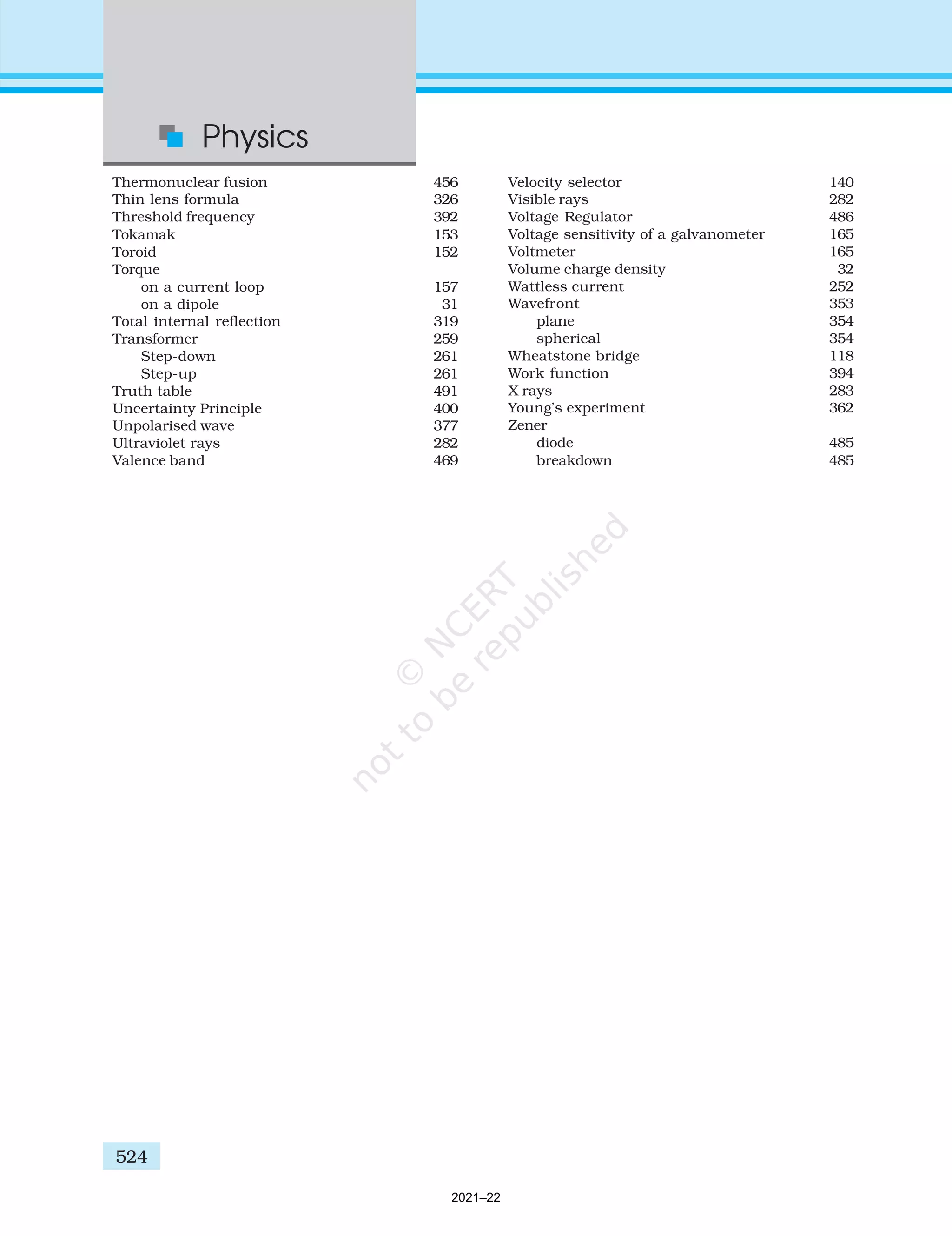This document provides appendices and answers for physics questions. Appendix A1 lists the Greek alphabet. Appendix A2 lists common SI prefixes and symbols for multiples and submultiples. Appendix A3 lists some important physical constants. The rest of the document provides answers to physics questions from Chapters 9 and 10 related to geometrical optics, physical optics, and light.
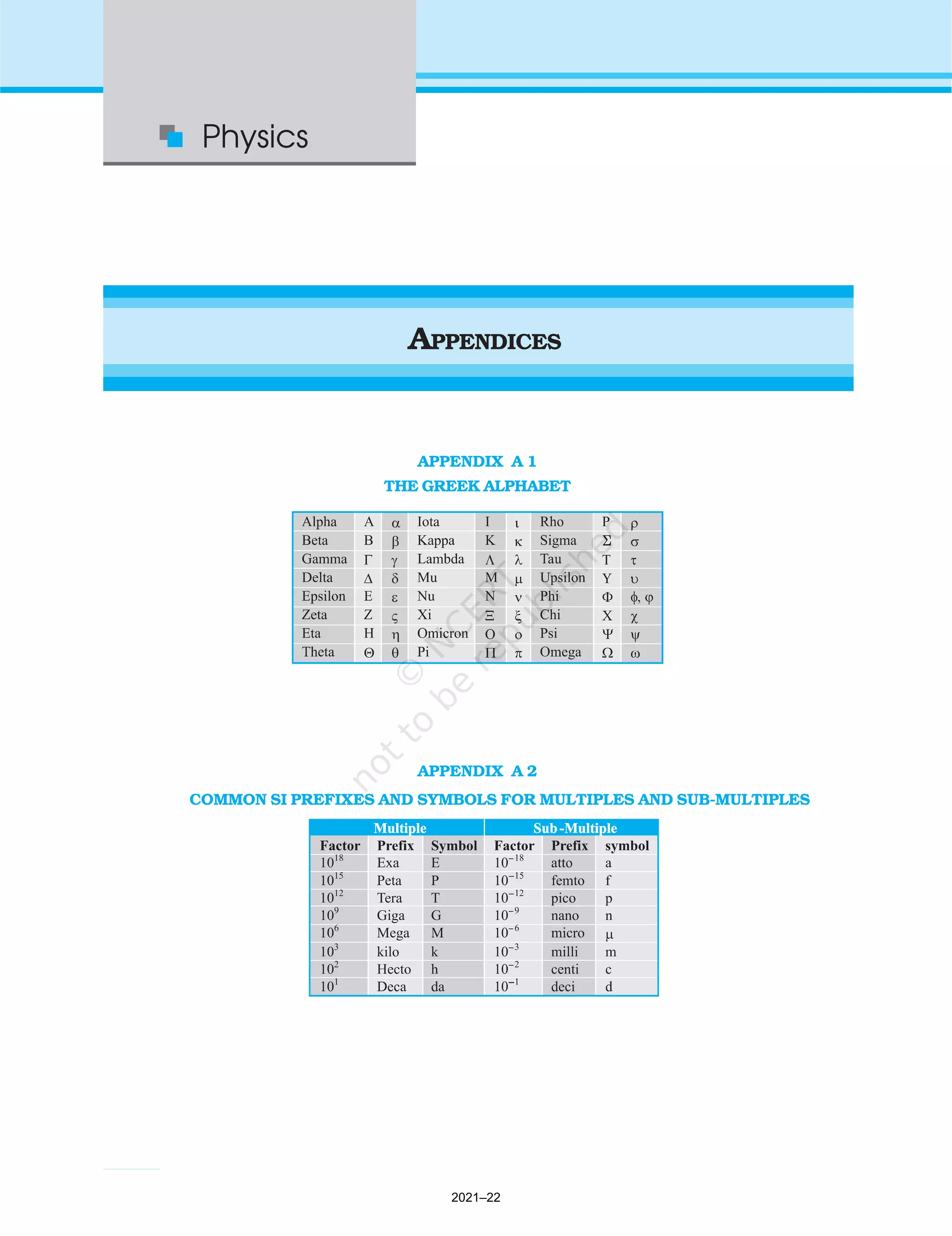
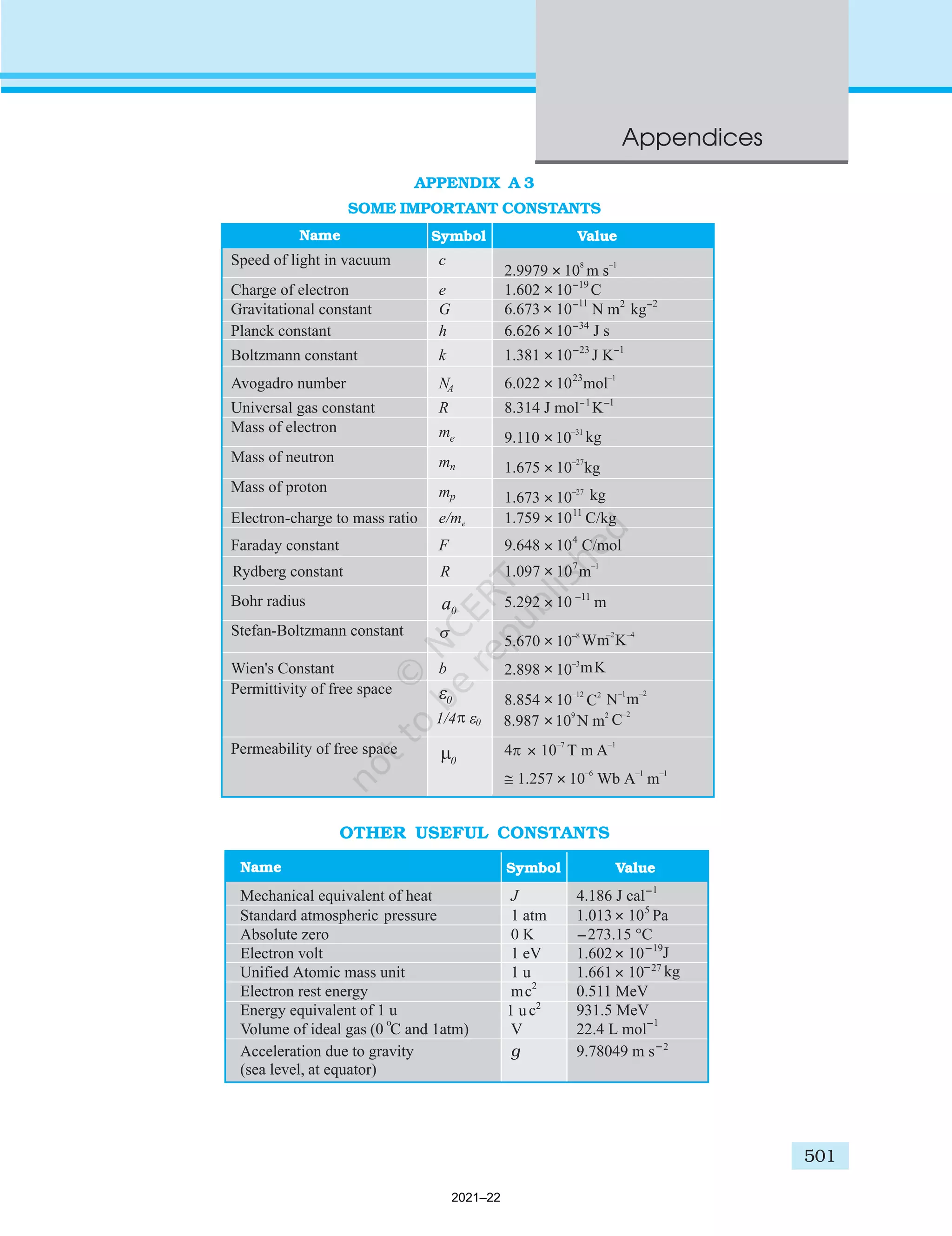
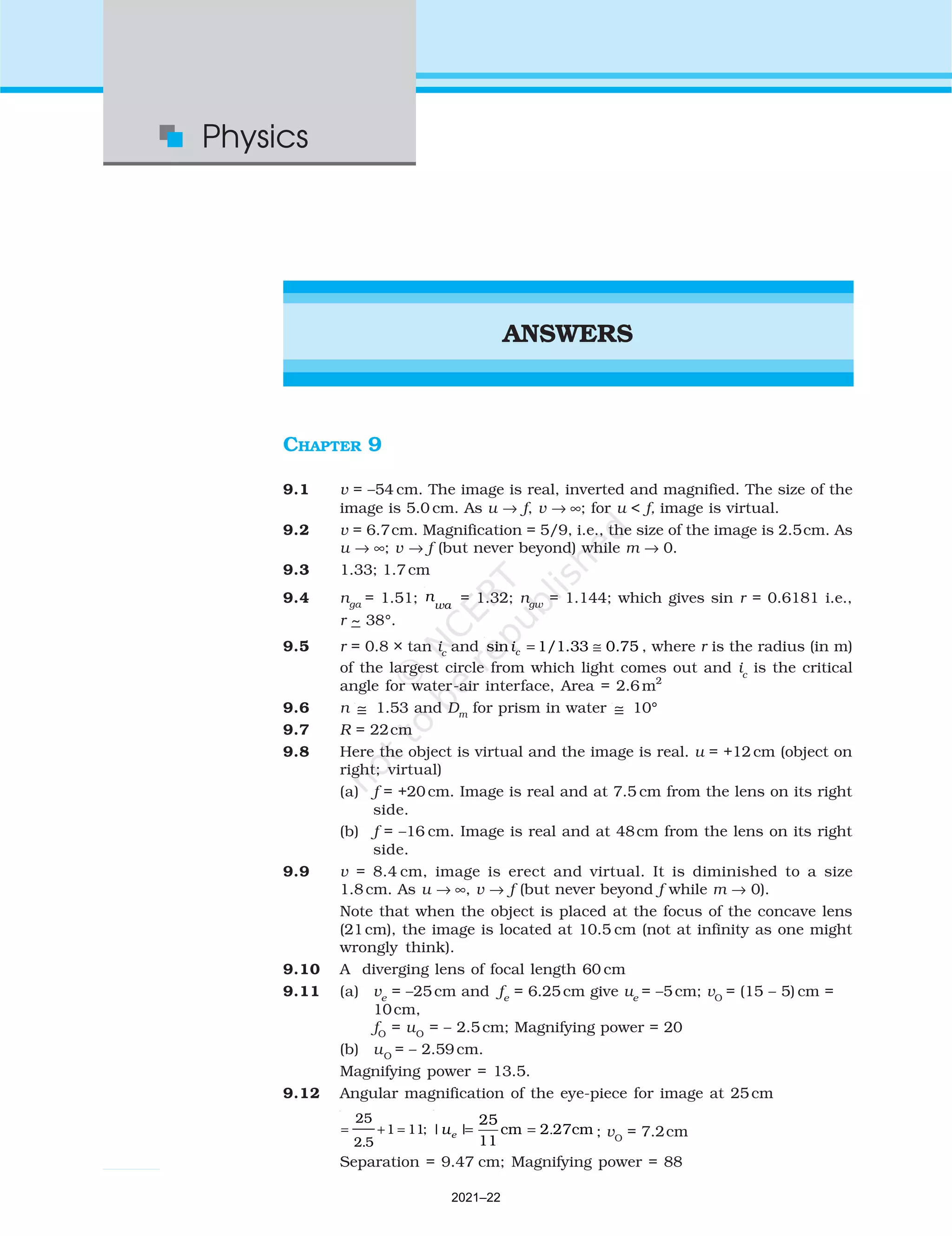
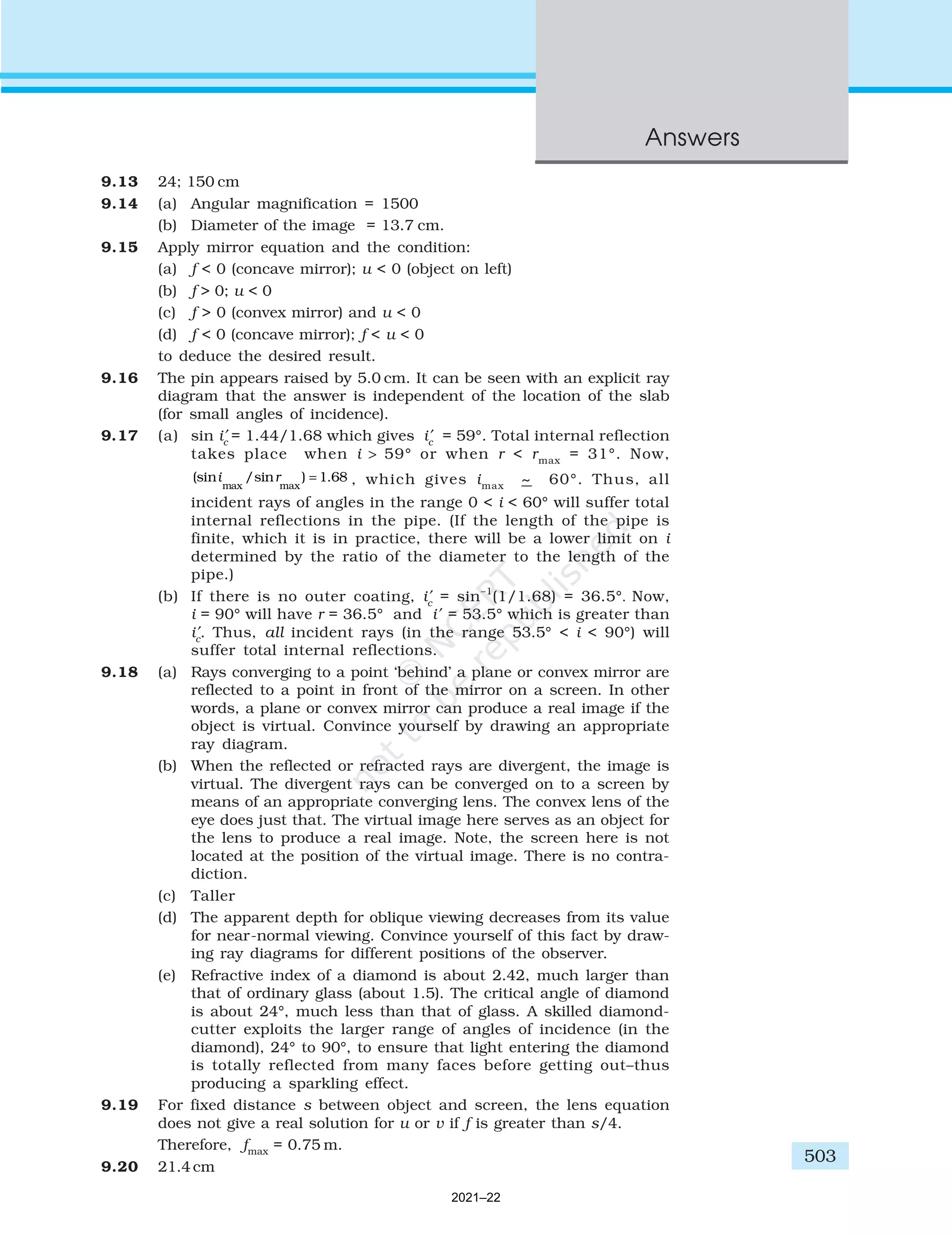
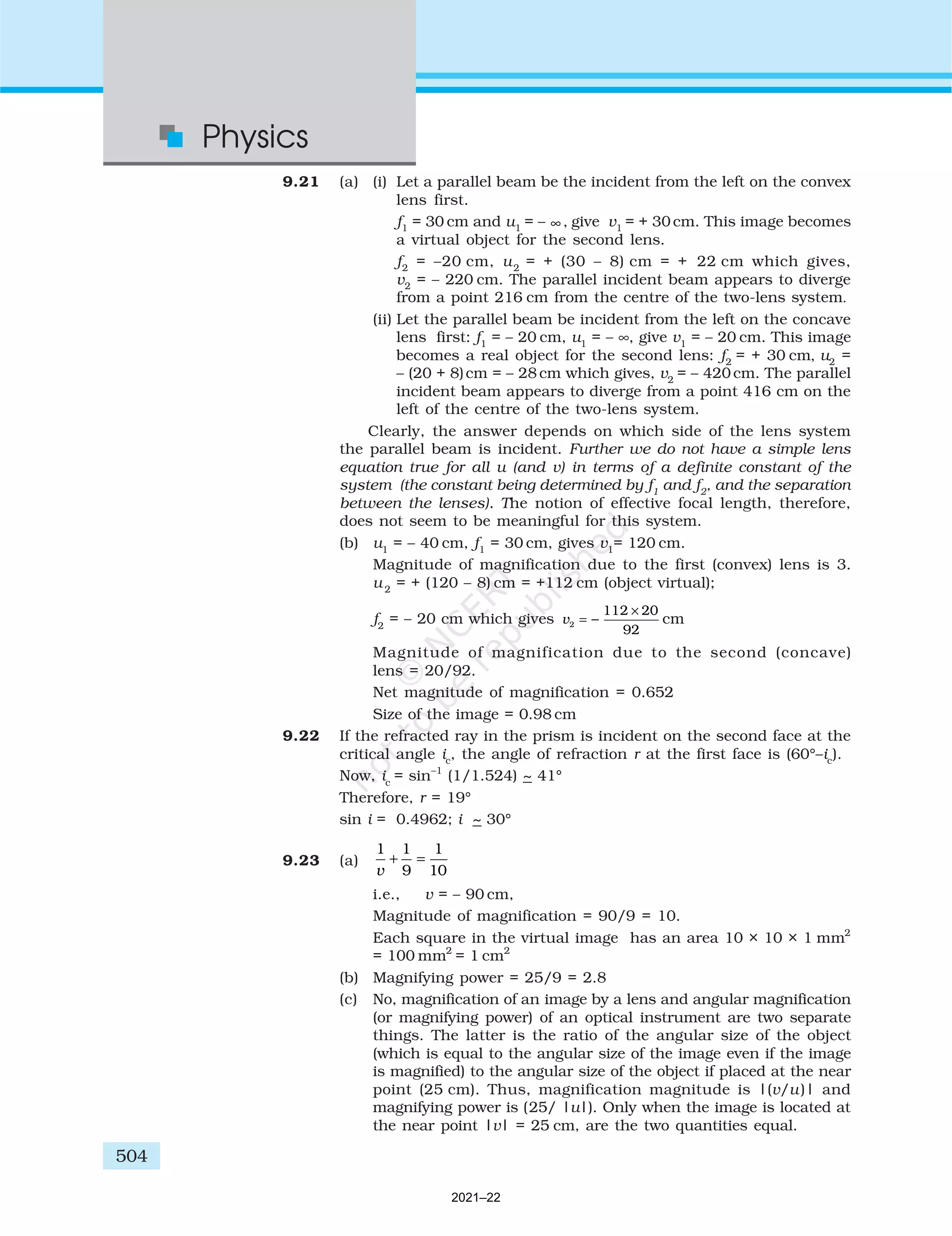
![505
Answers
9.24 (a) Maximum magnifying power is obtained when the image is at
the near point (25 cm)
u = – 7.14 cm.
(b) Magnitude of magnification = (25/ |u|) = 3.5.
(c) Magnifying power = 3.5
Yes, the magnifying power (when the image is produced at 25 cm)
is equal to the magnitude of magnification.
9.25 Magnification = ( . / )
6 25 1 = 2.5
v = +2.5u
+ − =
1
2 5
1 1
10
. u u
i.e.,u = – 6 cm
|v| = 15 cm
The virtual image is closer than the normal near point (25 cm) and
cannot be seen by the eye distinctly.
9.26 (a) Even though the absolute image size is bigger than the object
size, the angular size of the image is equal to the angular size of
the object. The magnifier helps in the following way: without it
object would be placed no closer than 25 cm; with it the object
can be placed much closer. The closer object has larger angular
size than the same object at 25 cm. It is in this sense that angular
magnification is achieved.
(b) Yes, it decreases a little because the angle subtended at the eye
is then slightly less than the angle subtended at the lens. The
effect is negligible if the image is at a very large distance away.
[Note: When the eye is separated from the lens, the angles
subtended at the eye by the first object and its image are not
equal.]
(c) First, grinding lens of very small focal length is not easy. More
important, if you decrease focal length, aberrations (both spherical
and chromatic) become more pronounced. So, in practice, you
cannot get a magnifying power of more than 3 or so with a simple
convex lens. However, using an aberration corrected lens system,
one can increase this limit by a factor of 10 or so.
(d) Angular magnification of eye-piece is [(25/fe
) + 1] ( fe
in cm) which
increases if fe
is smaller. Further, magnification of the objective
is given by
O
O O O
1
| | (| |/ ) 1
v
u u f
=
−
which is large when O
| |
u is slightly greater than fO
. The micro-
scope is used for viewing very close object. So O
| |
u is small, and
so is fO
.
(e) The image of the objective in the eye-piece is known as ‘eye-ring’.
All the rays from the object refracted by objective go through the
eye-ring. Therefore, it is an ideal position for our eyes for viewing.
If we place our eyes too close to the eye-piece, we shall not collect
much of the light and also reduce our field of view. If we position
2021–22](https://image.slidesharecdn.com/appendixandanswers-230110182633-e4e972f2/75/Appendix-and-Answers-pdf-6-2048.jpg)
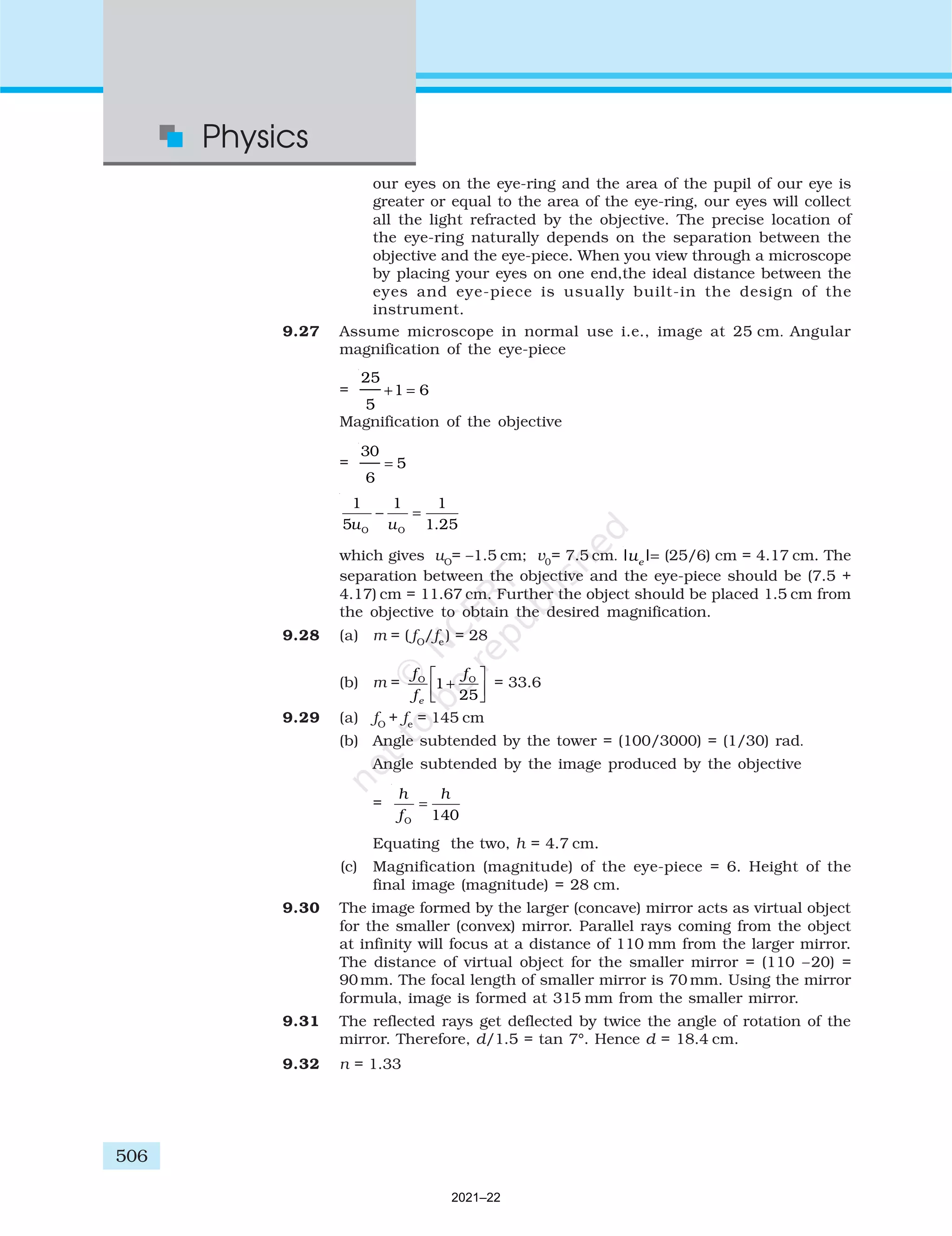
![507
Answers
CHAPTER 10
10.1 (a) Reflected light: (wavelength, frequency, speed same as incident
light)
λ = 589 nm, ν = 5.09 × 1014
Hz, c = 3.00 × 108
m s–1
(b) Refracted light: (frequency same as the incident frequency)
ν = 5.09 × 1014
Hz
v = (c/n) = 2.26 × 108
ms–1
, λ = (v/ν) = 444 nm
10.2 (a) Spherical
(b) Plane
(c) Plane (a small area on the surface of a large sphere is nearly
planar).
10.3 (a) 2.0 × 108
ms–1
(b) No. The refractive index, and hence the speed of light in a
medium, depends on wavelength. [When no particular
wavelength or colour of light is specified, we may take the given
refractive index to refer to yellow colour.] Now we know violet
colour deviates more than red in a glass prism, i.e. nv
> nr
.
Therefore, the violet component of white light travels slower than
the red component.
10.4 λ =
× × ×
×
12 10 0 28 10
4 1 4
. .
.
–2 – 3
m = 600 nm
10.5 K/4
10.6 (a) 1.17 mm (b) 1.56 mm
10.7 0.15°
10.8 tan–1
(1.5) ~ 56.3o
10.9 5000 Å, 6 × 1014
Hz; 45°
10.10 40m
10.11 Use the formula λ′ – λ =
v
c
λ
i.e., v =
c
λ
λ λ
( ' − ) =
6563
15
10
3 8
×
×
= 6.86 × 105
m s–1
10.12 In corpuscular (particle) picture of refraction, particles of light
incident from a rarer to a denser medium experience a force of
attraction normal to the surface. This results in an increase in the
normal component of the velocity but the component along the surface
is unchanged. This means
c sin i = v sin r or
v
c r
n
i
= =
sin
sin
. Since n > 1, v > c.
The prediction is opposite to the experimental results (v < c). The
wave picture of light is consistent with the experiment.
2021–22](https://image.slidesharecdn.com/appendixandanswers-230110182633-e4e972f2/75/Appendix-and-Answers-pdf-8-2048.jpg)
![508
Physics
10.13 With the point object at the centre, draw a circle touching the mirror.
This is a plane section of the spherical wavefront from the object
that has just reached the mirror. Next draw the locations of this
same wavefront after a time t in the presence of the mirror, and in
the absence of the mirror. You will get two arcs symmetrically located
on either side of the mirror. Using simple geometry, the centre of the
reflected wavefront (the image of the object) is seen to be at the same
distance from the mirror as the object.
10.14 (a) The speed of light in vacuum is a universal constant independent
of all the factors listed and anything else. In particular, note the
surprising fact that it is independent of the relative motion
between the source and the observer. This fact is a basic axiom
of Einstein’s special theory of relativity.
(b) Dependence of the speed of light in a medium:
(i) does not depend on the nature of the source (wave speed is
determined by the properties of the medium of propagation.
This is also true for other waves, e.g., sound waves, water
waves, etc.).
(ii) independent of the direction of propagation for isotropic
media.
(iii) independent of the motion of the source relative to the
medium but depends on the motion of the observer relative
to the medium.
(iv) depends on wavelength.
(v) independent of intensity. [For high intensity beams,
however, the situation is more complicated and need not
concern us here.]
10.15 Sound waves require a medium for propagation. Thus even though
the situations (i) and (ii) may correspond to the same relative motion
(between the source and the observer), they are not identical
physically since the motion of the observer relative to the medium
is different in the two situations. Therefore, we cannot expect
Doppler formulas for sound to be identical for (i) and (ii). For light
waves in vacuum, there is clearly nothing to distinguish between
(i) and (ii). Here only the relative motion between the source and the
observer counts and the relativistic Doppler formula is the same for
(i) and (ii). For light propagation in a medium, once again like for
sound waves, the two situations are not identical and we should
expect the Doppler formulas for this case to be different for the two
situations (i) and (ii).
10.16 3.4 × 10– 4
m.
10.17 (a) The size reduces by half according to the relation: size ~ λ/d.
Intensity increases four fold.
(b) The intensity of interference fringes in a double-slit arrangement
is modulated by the diffraction pattern of each slit.
(c) Waves diffracted from the edge of the circular obstacle interfere
constructively at the centre of the shadow producing a bright
spot.
(d) For diffraction or bending of waves by obstacles/apertures by a
large angle, the size of the latter should be comparable to
wavelength. If the size of the obstacle/aperture is much too large
compared to wavelength, diffraction is by a small angle. Here
the size is of the order of a few metres. The wavelength of light is
about 5 × 10–7
m, while sound waves of, say, 1 kHz frequency
2021–22](https://image.slidesharecdn.com/appendixandanswers-230110182633-e4e972f2/75/Appendix-and-Answers-pdf-9-2048.jpg)
![509
Answers
have wavelength of about 0.3 m. Thus, sound waves can bend
around the partition while light waves cannot.
(e) Justification based on what is explained in (d). Typical sizes of
apertures involved in ordinary optical instruments are much
larger than the wavelength of light.
10.18 12.5 cm.
10.19 0.2 nm.
10.20 (a) Interference of the direct signal received by the antenna with
the (weak) signal reflected by the passing aircraft.
(b) Superposition principle follows from the linear character of the
(differential) equation governing wave motion. If y1
and y2
are
solutions of the wave equation, so is any linear combination of
y1
and y2
. When the amplitudes are large (e.g., high intensity laser
beams) and non-linear effects are important, the situation is far
more complicated and need not concern us here.
10.21 Divide the single slit into n smaller slits of width a ′ = a/n. The angle
θ = nλ/a = λ/a ′. Each of the smaller slits sends zero intensity in the
direction θ. The combination gives zero intensity as well.
CHAPTER 11
11.1 (a) 7.24 × 1018
Hz (b) 0.041 nm
11.2 (a) 0.34 eV = 0.54 × 10–19
J (b) 0.34V (c) 344 km/s
11.3 1.5eV = 2.4 × 10–19
J
11.4 (a) 3.14 × 10–19
J, 1.05 × 10–27
kg m/s (b) 3 × 1016
photons/s
(c) 0.63 m/s
11.5 4 × 1021
photons/m2
s
11.6 6.59 × 10–34
Js
11.7 (a) 3.38 × 10–19
J = 2.11 eV (b) 3.0 × 1020
photons/s
11.8 2.0 V
11.9 No, because ν < νo
11.10 4.73 × 1014
Hz
11.11 2.16 eV = 3.46 × 10–19
J
11.12 (a) 4.04 × 10–24
kg m s–1
(b) 0.164 nm
11.13 (a) 5.92 × 10–24
kg m s–1
(b) 6.50 × 106
m s–1
(c) 0.112 nm
11.14 (a) 6.95 × 10–25
J = 4.34 µeV (b) 3.78 × 10–28
J = 0.236 neV
11.15 (a) 1.7 × 10–35
m (b) 1.1 × 10–32
m (c) 3.0 × 10–23
m
11.16 (a) 6.63 × 10–25
kg m/s (for both) (b) 1.24 keV (c) 1.51 eV
11.17 (a) 6.686 × 10–21
J = 4.174 × 10–2
eV (b) 0.145 nm
11.18 λ = h/p = h/(hν/c) = c/ν
11.19 0.028 nm
11.20 (a) Use eV = (m v2
/2) i.e., v = [(2eV/m)]1/2
; v = 1.33 × 107
m s–1
.
(b) If we use the same formula with V = 107
V, we get v = 1.88 ×
109
m s–1
. This is clearly wrong, since nothing can move with a
speed greater than the speed of light (c = 3 × 108
m s–1
). Actually,
the above formula for kinetic energy (m v2
/2) is valid only when
(v/c) << 1. At very high speeds when (v/c ) is comparable to
(though always less than) 1, we come to the relativistic domain
2021–22](https://image.slidesharecdn.com/appendixandanswers-230110182633-e4e972f2/75/Appendix-and-Answers-pdf-10-2048.jpg)

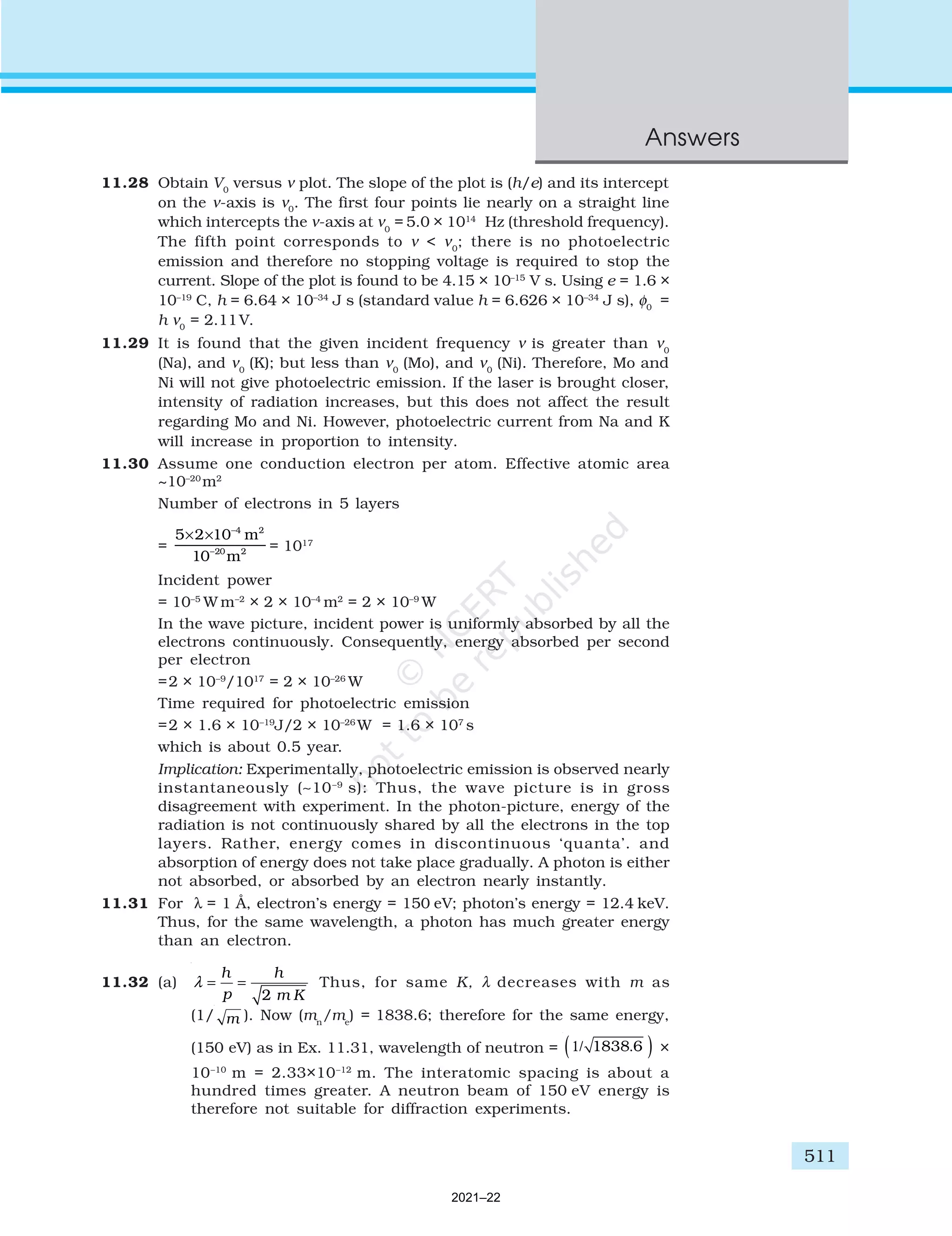
![512
Physics
(b) λ = 1.45 × 10–10
m [Use λ =( / 3 )
h m k T ] which is comparable
to interatomic spacing in a crystal.
Clearly, from (a) and (b) above, thermal neutrons are a suitable
probe for diffraction experiments; so a high energy neutron beam
should be first thermalised before using it for diffraction.
11.33 λ = 5.5 × 10–12
m
λ (yellow light) = 5.9 × 10–7
m
Resolving Power (RP) is inversely proportional to wavelength. Thus,
RP of an electron microscope is about 105
times that of an optical
microscope. In practice, differences in other (geometrical) factors
can change this comparison somewhat.
11.34
–34
–15
6.63 10 Js
10 m
h
p
λ
×
=
= = 6.63 × 10–19
kg m s–1
Use the relativistic formula for energy:
E2
= c2
p2
+ m0
2
c4
= 9 × (6.63)2
× 10–22
+ (0.511 × 1.6)2
× 10–26
∼ 9 × (6.63)2
× 10–22
,
the second term (rest mass energy) being negligible.
Therefore, E = 1.989 × 10–10
J = 1.24 BeV. Thus, electron energies
from the accelerator must have been of the order of a few BeV.
11.35 Use
3
h
m k T
λ = ; mHe
=
4 10
6 10
3
23
×
×
kg
This gives λ = 0.73 × 10–10
m. Mean separation
r = (V/N)1/3
= (kT/p)1/3
For T = 300 K, p = 1.01 × 105
Pa, r = 3.4 × 10–9
m. We find r >> λ.
11.36 Using the same formula as in Exercise 11.35, λ = 6.2 × 10–9
m which
is much greater than the given inter-electron separation.
11.37 (a) Quarks are thought to be confined within a proton or neutron
by forces which grow stronger if one tries to pull them apart. It,
therefore, seems that though fractional charges may exist in
nature, observable charges are still integral multiples of e.
(b) Both the basic relations e V = (1/2) m v 2
or e E = m a and
e B v =m v2
/r, for electric and magnetic fields, respectively, show
that the dynamics of electrons is determined not by e, and m
separately but by the combination e/m.
(c) At low pressures, ions have a chance to reach their respective
electrodes and constitute a current. At ordinary pressures, ions
have no chance to do so because of collisions with gas molecules
and recombination.
(d) Work function merely indicates the minimum energy required
for the electron in the highest level of the conduction band to
get out of the metal. Not all electrons in the metal belong to this
level. They occupy a continuous band of levels. Consequently,
for the same incident radiation, electrons knocked off from
different levels come out with different energies.
(e) The absolute value of energy E (but not momentum p) of any
particle is arbitrary to within an additive constant. Hence, while
λ is physically significant, absolute value of ν of a matter wave of
an electron has no direct physical meaning. The phase speed νλ
2021–22](https://image.slidesharecdn.com/appendixandanswers-230110182633-e4e972f2/75/Appendix-and-Answers-pdf-13-2048.jpg)

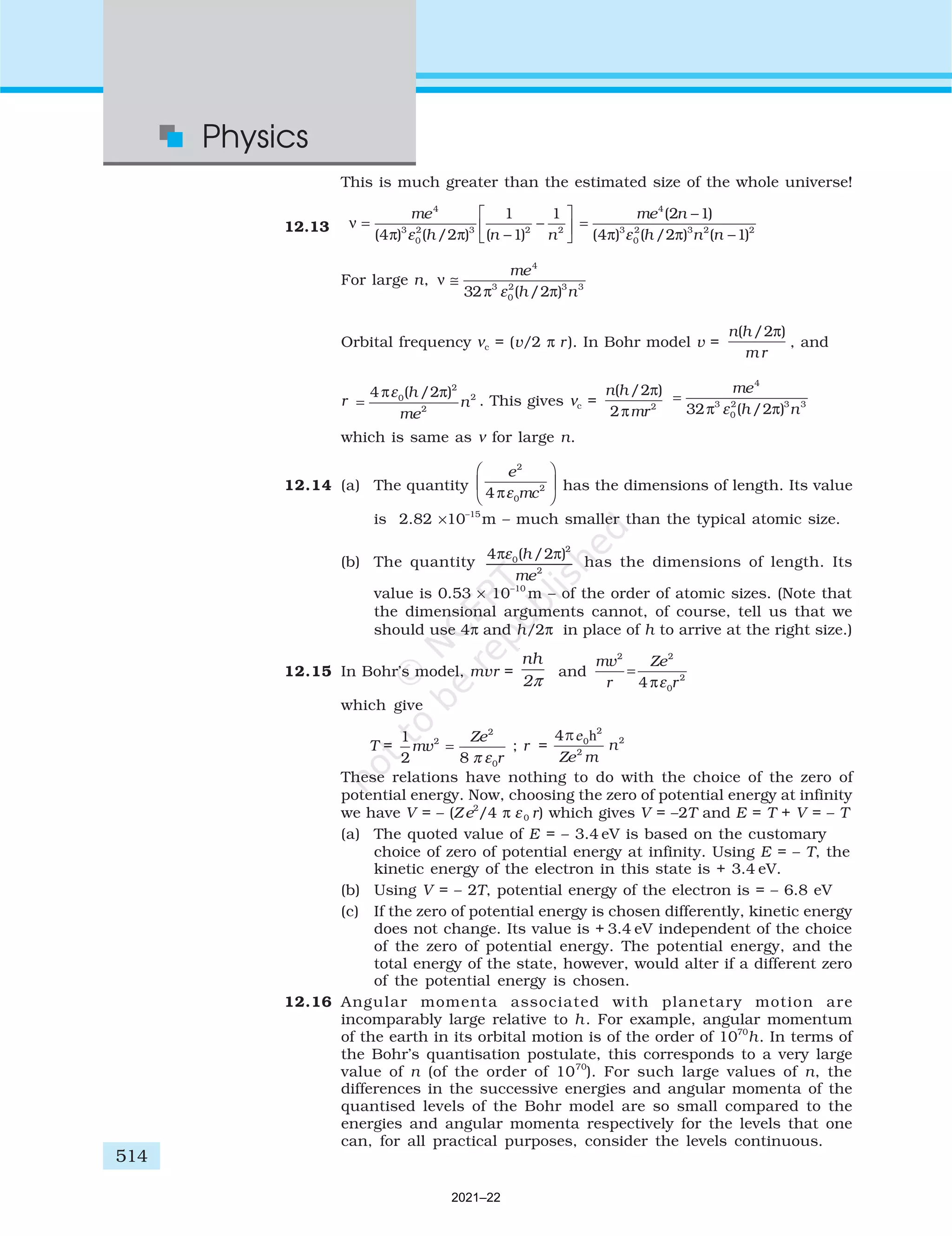

![516
Physics
been cancelled. Using given masses, Q = 4.37 MeV. As in Exercise 13.13,
maximum kinetic energy of the electron (max Ee
) = Q = 4.37 MeV.
13.15 (i) Q = –4.03 MeV; endothermic
(ii) Q = 4.62 MeV; exothermic
13.16 Q = ( ) ( )
56 28
26 13
Fe – 2 Al
m m = 26.90 MeV; not possible.
13.17 4.536 × 1026
MeV
13.18 Energy generated per gram of 235
92 U =
23 13
1
6 10 200 1.6 10
J g
235
−
−
× × × ×
The amount of 235
92U consumed in 5y with 80% on-time
=
16
13
5 0.8 3.154 10 235
g
1.2 1.6 10
× × × ×
× ×
= 1544 kg
The initial amount of 235
92U = 3088 kg.
13.19 About 4.9 × 104
y
13.20 360 KeV
13.22 Consider the competing processes:
+
–1 1
X Y +e
A A
Z Z e Q
ν
→ + + (positron emission)
–
–1 2
X Y
A A
Z Z e
e Q
ν
+ → + + (electron capture)
Q1
= ( ) ( )
m m m c
N Z
A
N Z
A
e
X Y
– –
–1
2
= ( ) ( )
m m m c
Z
A
Z
A
e
X Y
– –
–1
2
2
Q2
= ( )+ ( )
m m m c
N Z
A
e N Z
A
X Y
– –1
2
= ( ) ( )
m m c
Z
A
Z
A
X Y
– –1
2
This means Q1
> 0 implies Q2
> 0 but Q2
> 0 does not necessarily
mean Q1
> 0. Hence the result.
13.23 25
12 Mg : 9.3%, 26
12 Mg :11.7%
13.24 Neutron separation energy Sn
of a nucleus A
Z X is
S m m m c
n = + −
−
N Z
A 1
n N Z
A 2
( X) ( X)
From given data , 41 27
20 13
( Ca) 8.36MeV, ( Al) 13.06MeV
n n
S S
= =
13.25 209 d
13.26 For 14
6C emission
223 209 14 2
88 82 6
[ ( Ra) ( Pb) ( C)]
N N N
Q m m m c
= − −
223 209 14 2
88 82 6
[ ( Ra) ( Pb) ( C)]
m m m c
= − − = 31.85 MeV
For 4
2 He emission, 223 219 4 2
88 86 2
[ ( Ra) ( Rn) ( He)]
Q m m m c
= − − = 5.98MeV
13.27 238 140 99 2
92 n 58 44
[ ( U) ( Ce) ( Ru)]
Q m m m m c
= + − − = 231.1 MeV
2021–22](https://image.slidesharecdn.com/appendixandanswers-230110182633-e4e972f2/75/Appendix-and-Answers-pdf-17-2048.jpg)
![517
Answers
13.28 (a) 2 3 4 2
1 1 2 n
[ ( H) ( H) ( He) ] 17.59 MeV
Q m m m m c
= + − − =
(b) K.E. required to overcome Coulomb repulsion = 480.0 keV
480.0 KeV = 7.68×10–14
J = 3kT
–14
–23 –1
–23
J K )
7.68 10
( 1.381 10
3 1.381 10
T as k
×
= = ×
× ×
∴
= 1.85 ×109
K (required temperature)
13.29 ( ) ( )
– –
1 2
0.284 MeV, 0.960 MeV
max max
K K
β β
= =
( ) 20
1 2.627 10 Hz
ν γ = × , ( ) 20
2 0.995 10 Hz
ν γ = × , ( ) 20
3 1.632 10 Hz
ν γ = ×
13.30 (a) Note that in the interior of Sun, four 1
1H nuclei combine to form
one 4
2 He nucleus releasing about 26 MeV of energy per event.
Energy released in fusion of 1kg of hydrogen = 39 ×1026
MeV
(b) Energy released in fission of 1kg of 235
92U = 5.1×1026
MeV
The energy released in fusion of 1 kg of hydrogen is about 8
times that of the energy released in the fission of 1kg of uranium.
13.31 3.076 × 104
kg
CHAPTER 14
14.1 (c)
14.2 (d)
14.3 (c)
14.4 (c)
14.5 (c)
14.6 50 Hz for half-wave, 100 Hz for full-wave
14.7 No (hν has to be greater than Eg
).
14.8 ne
≈ 4.95 × 1022
; nh
= 4.75 × 109
; n-type since ne
>> nh
For charge neutrality ND
– NA
= ne
– nh
; ne
.nh
= ni
2
Solving these equations, ne
=
1
2
4
2 2
N N N N n
D A D A i
−
( )+ −
( ) +
14.9 About 1 × 105
14.10 (a) 0.0629 A, (b) 2.97 A, (c) 0.336 Ω
(d) For both the voltages, the current I will be almost equal to I0
,
showing almost infinite dynamic resistance in the reverse bias.
14.12 NOT ; A Y
0 1
1 0
14.13 (a) AND (b) OR
14.14 OR gate
14.15 (a) NOT, (b) AND
2021–22](https://image.slidesharecdn.com/appendixandanswers-230110182633-e4e972f2/75/Appendix-and-Answers-pdf-18-2048.jpg)
